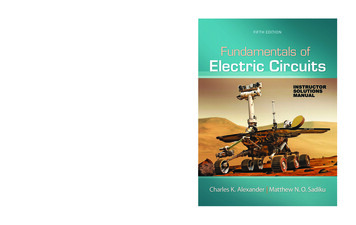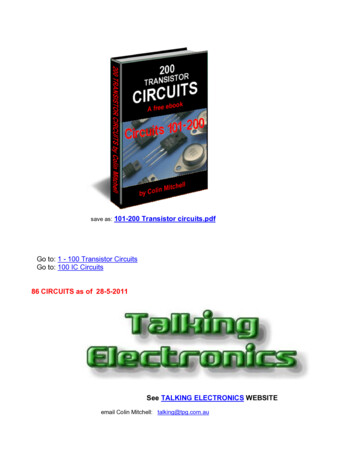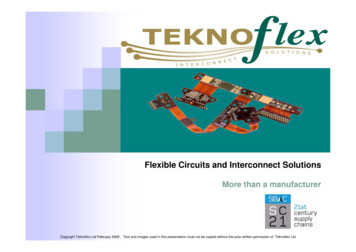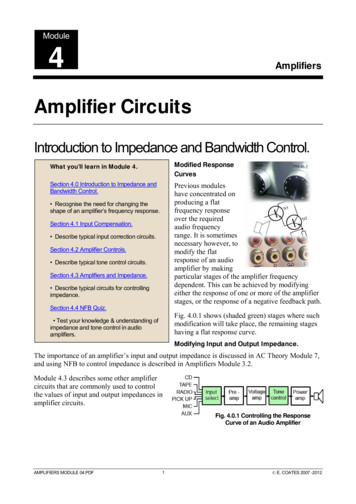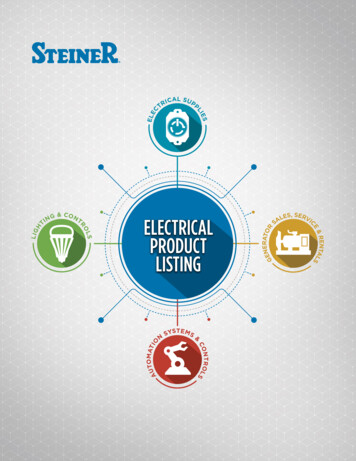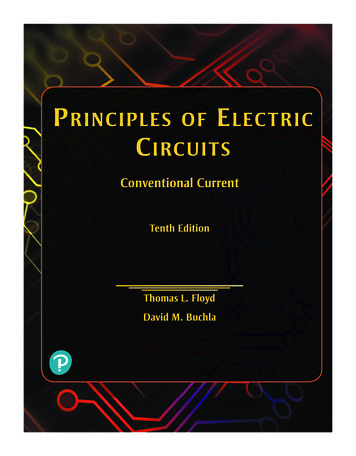
Transcription
P rinciples of E lec tricC ircuitsConventional CurrentTenth EditionThomas L. FloydDavid M. BuchlaA01 FLOY9482 10 SE FM.indd 105/12/18 11:14 AM
Vice President, Portfolio Management: AndrewGilfillanPortfolio Management Assistant: Lara DimmickSenior Vice President, Marketing: David GesellMarketing Coordinator: Elizabeth MacKenzieLambDirector, Digital Studio and Content Production:Brian HylandManaging Producer: Jennifer SargunarContent Producer (Team Lead): Faraz ShariqueAliContent Producer: Deepali MalhotraManager, Rights Management: Johanna BurkeOperations Specialist: Deidra SmithCover Design: Pearson CSCCover Credit: Semisatch/ShutterstockFull-Service Project Management: IntegraSoftware Service Pvt. Ltd.Printer/Binder: LSC CommunicationsCover Printer: Phoenix Color/HagerstownText Font: TimesNRMTProCredits and acknowledgments for materials borrowed from other sources and reproduced, with permission, in this textbook appear on the appropriate page within the text.Microsoft and Windows are registered trademarks of the Microsoft Corporation in the U.S.A. andother countries. Screen shots and icons reprinted with permission from the Microsoft Corporation.This book is not sponsored or endorsed by or affiliated with the Microsoft Corporation.Copyright 2020, 2010, 2007 by Pearson Education, Inc. 221 River Street, Hoboken, NJ 07030. AllRights Reserved. Manufactured in the United States of America. This publication is protected bycopyright, and permission should be obtained from the publisher prior to any prohibited reproduction, storage in a retrieval system, or transmission in any form or by any means, electronic, mechanical,photocopying, recording, or otherwise. For information regarding permissions, request forms, and theappropriate contacts within the Pearson Education Global Rights and Permissions department, pleasevisit www.pearsoned.com/permissions/.Acknowledgments of third-party content appear on the appropriate page within the text.Unless otherwise indicated herein, any third-party trademarks, logos, or icons that may appearin this work are the property of their respective owners, and any references to third-party trademarks, logos, icons, or other trade dress are for demonstrative or descriptive purposes only. Suchreferences are not intended to imply any sponsorship, endorsement, authorization, or promotionof Pearson’s products by the owners of such marks, or any relationship between the owner andPearson Education, Inc., authors, licensees, or distributors.Library of Congress Cataloging-in-Publication DataNames: Floyd, Thomas L., author. Buchla, David M., author.Title: Principles of electric circuits : conventional current /Thomas L. Floyd and David M. Buchla.Description: Tenth edition. New York : Pearson, [2020] Includes index.Identifiers: LCCN 2018054879 ISBN 9780134879482Subjects: LCSH: Electric circuits.Classification: LCC TK454 .F56 2018 DDC 621.319/2—dc22LC record available at https://lccn.loc.gov/2018054879118ISBN-13: 978-0-13-487948-2ISBN-10:0-13-487948-1A01 FLOY9482 10 SE FM.indd 205/12/18 11:14 AM
In memory of Thomas L. FloydAuthor, educator, and friendThe first edition of Principles of Electric Circuits, released in 1981, was a breakthroughtext that featured Tom Floyd’s unique ability to present electronics clearly and precisely. As electronics evolved, Tom improved and updated this best-selling text throughseveral editions, and it continued to be one of the most popular basic electronics bookson the market. Although his health intervened with writing, Tom outlined changes hethought should be made to the text and asked me to implement his ideas in this newedition. I am honored for the opportunity and hope I succeeded in that endeavor.A01 FLOY9482 10 SE FM.indd 305/12/18 11:14 AM
P refaceIn the years that have passed since the last edition of this classic text, there have beenmany changes in technology. Fundamental circuit laws and components remain thefocus of the text but with updated instruments and methods including new computersimulations with both Multisim and LTSpice. One important change to this edition isillustrated steps for solving problems with simultaneous equations and complex mathematics using a graphing calculator. Graphing calculators have increased capabilitiesand are much more affordable, so are an important tool in basic electronics. The numerous pedagogical features that have been hallmarks of this book have been retainedand expanded. This includes practical application of basic concepts, basic troubleshooting, and use of instruments.The entire text has been reviewed with an eye for improving and updating it.Every example has been reworked and checked. In that process, the full resolution of a calculator was kept until the end before final roundoff to three digits.This has improved round-off errors from previous editions. The entire text wasalso reviewed for improving readability and clarity, with many modifications. Oureffort has been to continue the tradition of having the best introduction to basicelectronics on the market.New in This Edition Numerous examples including step-by-step procedures for solving problemswith the TI-84 Plus CE graphing calculator including graphing examples, m atrixalgebra, phasors and moreNew instruments described with expanded discussion and use of arbitrary function generators (AFGs), arbitrary waveform generators (AWGs), oscilloscopesand probes, gaussmeters, LCR meters, thermal imaging devices, and currentpulser and tracersNew devices and applications such as magnetoresistive random access memory(MRAM), magnetohydrodynamic (MHD) generators, and wave traps in powerline carrier communications (PLCC)Many examples now include LTSpice including two examples of Bode plotswith both Multisim and LTSpice resultsNew discussion of dimensional analysis with examplesNew or enhanced discussion of SMD resistors, resistor power ratings, batteries, thermal imaging, ferrites and ferrite beads, contactors, and motorstartersAdded examples, safety notes, tech tips, checkup questions, history notes, newillustrations, and new and revised problemsExpanded glossary, key terms, and biographies of famous peopleA01 FLOY9482 10 SE FM.indd 405/12/18 11:14 AM
Preface vFeatures Full-color, reader-friendly text designChapter openers include a chapter outline, introduction, objectives, key termlist, Application Activity Preview, and website reference An Application Activity at the end of most chapters Abundant illustrations Margin features include Safety Notes, History Notes, and Tech Notes Abundance of worked examples, each with a Related Problem and selected examples with a Multisim exercise and/or LTSpice exercise Each section in a chapter begins with an introduction and section objectives Section Checkups with answers at end of chapter Troubleshooting sections in many chapters Summary, key terms glossary, and formula list at the end of each chapter True/False Quiz, multiple-choice Self-Test, and Circuit Dynamics Quiz at theend of each chapter with answers at the end of the chapterSectionalized problem set at the end of each chapter with more difficult problems indicated with an asterisk and answers to odd-numbered problems at theend of the bookComprehensive glossary of all bold-face terms in the text, including key terms,at the end of the bookConventional current directionStudent ResourcesDigital Resources (www.pearsonhighered.com/careersresources/) This section offersstudents an online study guide that they can check for conceptual understandingof key topics. Also available on the student resources website are multiple-choice,true/false, fill-in-the-blanks, and circuit analysis tests that can be used for additionalreinforcement of your grasp of the topics in the textbook.Circuit Simulations (www.pearsonhighered.com/careersresources/) These onlinefiles include simulation circuits in Multisim 14 and LT Spice IV for selected examples, troubleshooting sections, and selected problems in the text. Circuit fileswith prefix E are example circuits and files with prefix P are problem circuits.These circuits were created for use with Multisim or LT Spice software. Thesecircuit simulation programs are widely regarded as excellent for classroom andlaboratory learning.MultiSIM and LTSpice odd answers are shown with the results that the simulationsactually show, so they are not rounded off as are other answers.In order to use the Multisim circuit files, you must have Multisim software installedon your computer. Multisim software is available at Ni.com/Multisim. Althoughthe Multisim circuit files are intended to complement classroom, textbook, andlaboratory study, these files are not essential to successfully using Principles ofElectric Circuits, Tenth Edition.A01 FLOY9482 10 SE FM.indd 505/12/18 11:14 AM
vi PrefaceExperiments in Basic Circuits, Tenth Edition, lab manual by David Buchla(ISBN 10: 0134879988/ISBN-13: 9780134879987). Lab exercises are c oordinatedwith the text and solutions are provided in the Instructor’s Resource Manual.Experiments in Electric Circuits, Tenth Edition, lab manual by Brian Stanley(ISBN 10: 0134879996/ISBN-13: 9780134879994). Lab solutions are provided inthe Instructor’s Resource Manual.Introduction to Multisim for the DC/AC Course by Gary Snyder(ISBN: 013508041X). A thorough introduction and detailed guide to the use ofMultisim in DC/AC circuit analysis.Instructor ResourcesTo access supplementary materials online, instructors need to request an instructor access code. Go to www.pearsonhighered.com/irc, where you can register for aninstructor access code. Within 48 hours-after registering, you will receive a confirming e-mail, including an instructor access code. Once you have received yourcode, go to the site and log on for full instructions on downloading the materialsyou wish to use.PowerPoint Slides A set of innovative PowerPoint slides, dynamically illustrateskey concepts in the text. Each slide contains a summary with examples, key termdefinitions, and a quiz for each chapter. This is an excellent tool for classroompresentation to supplement the textbook. Another folder of PowerPoint slidescontains all figures from the text. The PowerPoints are available at the instructorresource website at www.pearsonhighered.com/irc.Instructor’s Resource Manual Includes solutions to chapter problems, solutions toApplication Activity features, a test item file, Multisim circuit file summary, andsolutions to both lab manuals. Available online at www.pearsonhighered.com/irc.Pearson TestGen This is a computerized test bank. Available online atwww. pearsonhighered.com/irc.Illustration of Chapter FeaturesChapter Opener Each chapter begins as shown in Figure P–1. Each chapter openerincludes the chapter number and title, a brief introduction, lists of text sections andchapter objectives, a key terms list, an Application Activity preview, and a websitereference for study aids and supplementary materials.Worked Examples and Related Problems Numerous worked examples throughouteach chapter help to illustrate and clarify basic concepts or specific procedures. Eachexample ends with a Related Problem that reinforces or expands on the exampleby requiring the student to work through a problem similar to the example. Manyexamples have a Multisim circuit exercise and most also have an LTSpice circuitexercise. A typical worked example with a Related Problem is shown in Figure P–2.Section Opener Each section in a chapter begins with a brief introduction thatincludes a general overview and section objectives. An illustration is given in Figure P–2.Section Checkup Each section in a chapter ends with a review consisting of questionsor exercises that emphasize the main concepts covered in the section. An example isshown in Figure P–2. Answers to the Section Checkups are at the end of the chapter.Application Activity Each chapter (except Chapters 1 and 21) presents a practicalapplication of certain topics covered in the chapter. In each activity, students applythe concepts covered in the chapter in a practical problem. Many of the activitiesinvolve comparing circuit board layouts with schematics, analyzing circuits, usingmeasurements to determine circuit operation, and in some cases, developing simpleA01 FLOY9482 10 SE FM.indd 605/12/18 11:14 AM
Preface vii F I G U R EP –1A typical chapter opener.Chapteroutline13I NDUCTORSList ofperformancebasedobjectivesStudy aids for this chapter are available The Basic InductorTypes of InductorsSeries and Parallel InductorsInductors in DC CircuitsInductors in AC CircuitsInductor ApplicationsApplication ActivityINTRODUCTIONYou have learned about the resistor and the capacitor. In thischapter, you will learn about a third type of basic passivecomponent, the inductor, and study its characteristics.The basic construction and electrical properties of inductors are discussed, and the effects of connecting them inseries and in parallel are analyzed. How an inductor works inboth dc and ac circuits is an important part of this coverageand forms the basis for the study of reactive circuits in termsof both frequency response and time response. You will alsolearn how to check for a faulty inductor.The inductor, which is basically a coil of wire, is basedon the principle of electromagnetic induction, which youstudied in Chapter 10. Inductance is the property of a coilof wire that opposes a change in current. The basis forinductance is the electromagnetic field that surrounds anyconductor when there is current through it. The electricalcomponent designed to have the property of inductanceis called an inductor, coil, or in certain high-frequencyapplications a choke. All of these terms refer to the sametype of device.CHAPTER OBJECTIVESN Describe the basic construction and characteristics ofan inductorN Discuss various types of inductorsN Analyze series and parallel inductorsN Analyze inductive dc switching circuitsN Analyze inductive ac circuitsN Discuss some inductor applicationsKey termsKEY eVISIT THE COMPANION WEBSITECHAPTER rWindingInduced voltageInductanceNNNNHenry (H)RL time constantInductive reactanceQuality factor (Q)ChapterintroductionAPPLICATION ACTIVITY PREVIEWIn this application activity, the inductance of coils is determined by measuring the time constant of a test circuit usingoscilloscope waveforms. F I G U R EExamples are setoff from textP –2Typical chapter features. Refer to Figure 8–54.EXAMPLE 8–17(a) Apply the current-divider rule to the input Norton circuit to calculate IN.(b) Use Ohm’s law to calculate VIN.(c) Determine the voltage from the dependent voltage source. This gain is 20.(d) Apply the voltage-divider rule to calculate VOUT.All examplesinclude arelated problem.(Many alsoinclude Multisimand LTSpicereferences.)Solution(a) IIN IN aRN1.0 MΩb 5 MAb (5.5 mA) aRN RIN1.1 MΩ(b) VIN IINR IN (5 mA)(100 kΩ) 0.5 V(c) 20VIN (20)(0.5 V) 10.0 V(d) VOUT (20 VIN) aRelated ProblemSECTION 8–6CHECKUPRLb (10.0 V)(0.403) 4.03 VRL ROUTIf the photocell is replaced by one having the same current but a Norton equivalentresistance of 2.0 MΩ, what is the output voltage?1. What are the two components of a Norton equivalent circuit?2. Draw the general form of a Norton equivalent circuit.3. How is IN defined?Sections endwith checkupexercises,set off from text.4. How is RN defined?5. Find the Norton circuit as seen by RL in Figure 8–55.R1R310 kV4.7 kV FI G UR E 8 – 5 5VS10 VSection openersinclude openingparagraphand objectives2AR210 kVRLB8–7M A XIMU M P O W E R T RANSFER T H EO R EMThe maximum power transfer theorem is important when you need to know thevalue of the load at which the most power is delivered from the source.After completing this section, you should be able to Apply the maximum power transfer theorem A01 FLOY9482 10 SE FM.indd 71State the theoremDetermine the value of load resistance for which maximum power istransferred from a given circuit05/12/18 11:14 AM
viii PrefaceApplication activities are set off from text and relate theory to practice. FIGURE 8–70Thermistor resistance as a functionof temperature.Application ActivityThe Wheatstone bridge circuitwas introduced in Chapter 7and expanded in this chapter to include the use of Thevenin’stheorem. In Chapter 7, the circuit application used a thermistor inone arm of the bridge to sense temperature. The bridge was usedto compare the resistance of the thermistor with the resistance ofa rheostat, which set the temperature at which the output wouldswitch from one polarity to the opposite for turning on a heaterin a tank filled with a liquid. In this application activity, you willwork with a similar circuit, but this time it will be used to monitorthe temperature in the tank to provide a visual indication that thetemperature is within a specified range.The Temperature MonitorThe basic measuring circuit in the temperature monitor isa Wheatstone bridge with an ammeter and a series resistor acting as the load. The meter is an analog panel meterwith a sensitivity of 50 mA full scale. The Wheatstone bridgetemperature-measuring circuit is shown in Figure 8–69(a),and the meter panel is shown in Figure 8–69(b).The ThermistorThe thermistor is the same one used in the circuit application ofChapter 7, specifically a Thermometrics RL2006-13.3K-140-D1thermistor with a specified resistance of 25 kΩ at 25 C and ab of 4615K. Recall that b is a constant supplied by the manufacturer that indicates the shape of the temperature-resistancecharacteristic. As given in Chapter 7, the exponential equationfor the resistance of a thermistor is approximated byR T R 0ebaT0 - TbT0TT temperature (K)b a constant (K) provided by the manufacturerA plot of this equation was given previously in Figure 7–59.You can confirm that your thermistor resistance calculations in this circuit application are in reasonable agreementwith this plot.If you have a graphing calculator such as the TI-84 PlusCE, you can easily reproduce the plot by entering the equationfor it after pressing the y key. Figure 8–70 shows the ploton a TI-84 Plus CE calculator. The equation is shown at thetop of the plot. R represents the resistance in ohms at the reference temperature (R0), T represents the reference temperaturein K, and B represents b in K. Pressing the trace buttonallows you to position the cursor along the graph to read values. Another way to see values is to press 2nd trace , whichbrings up a table of values. The table limits and the incrementbetween values is set in the 2nd window menu. The Table limitsand increment were set to a start value of 298 and an increment of 5. Figure 8–71 shows the values with the resistanceat 323 K selected. To simplify viewing temperature values inCelsius, a second equation is entered (Y2 X - 273), whichtabulated the temperature (in red) in Celsius.Temperature Measuring CircuitThe Wheatstone bridge is designed to be balanced at 20 C.The resistance of the thermistor is approximately 32.6 kΩat this temperature. You can confirm this value by substi tuting the temperature (in Kelvin) into the equation for RT.Remember that the temperature in K is C 273.1. Substituting into the equation for RT, calculate theresistance of the thermistor at a temperature of 50 C(full-scale deflection of the meter).where:RT the resistance at a given temperatureR0 the resistance at a reference temperatureT0 the reference temperature in K (typically298 K, which is 25 C)2. Thevenize the bridge between terminals A and B by keeping the ground reference and forming two facing Thevenincircuits as was illustrated in Figure 8–44. Assume theR333 kVARLR233 kVABRT25 kVTemperatureindicator4. Calculate the thermistor resistance for the lower andupper limits of temperature (30 C and 40 C). DrawThevenin circuits for each temperature and calculate thecurrent through the load resistor.(a) Temperature-measuring circuit with thermistor (b) Meter panel FIG UR Ethermistor temperature is 50 C and its resistance is thevalue calculated previously. Draw the Thevenin circuit forthis temperature but do not show a load.3. Show the load resistor for the Thevenin circuit you drew.The load is a resistor in series with the ammeter, whichwill have a current of 50 mA at full scale (50 C). You canfind the value of the required load resistor by applyingthe superposition theorem to the two sources and calculating the total resistance from Ohm’s law (using the fullscale deflection as the current). Subtract the Theveninresistance of each arm from the total resistance to obtain the required load resistance. Neglect the meter resistance. Show the value calculated on the Thevenin circuit. FIGURE 8–69115 VR133 kV FIGURE 8–71Table of calculated resistance (blue)as a function of temperature inCelsius (red).The Meter ScaleA requirement for the temperature monitor is to markthree color bands on the meter to indicate that the temperature is within the desired range. The desired range is between a low of 30 C and 40 C. The meter should indicatea too-cold range from 20 C to 30 C, a proper operatingrange from 30 C to 40 C, and a too-hot range from 40 Cand 50 C. Full-scale deflection of the meter should be setfor 50 C.5. Indicate how you would mark the meter to have aquick visual indication of the temperature in thetank.Review6. At 35 C, what is the current in the meter?7. What change is needed if a 100 mA meter is usedinstead of a 50 mA meter?P–3Typical application assignment.test procedures. Results and answers are found in the Instructor’s Resource Manual.A typical Application Activity is shown in Figure P–3.Troubleshooting Sections Many chapters include a troubleshooting section thatrelates to the topics covered in the chapter and emphasizes logical thinking as wellas a structured approach called APM (analysis, planning, and measurement) whereapplicable. Particular troubleshooting methods, such as half-splitting, are appliedwhen appropriate.Chapter End Mattereach chapter: Summary Key terms glossary Formula list True/False Quiz Self-Test Circuit Dynamics Quiz Problems A01 FLOY9482 10 SE FM.indd 8The following pedagogical features are found at the end ofAnswers to section checkups, related problems for examples, true/false quiz, selftest, and the circuit dynamics quiz05/12/18 11:14 AM
Preface ixSuggestions for Teaching with Principles of Electric CircuitsSelected Course Emphasis and Flexibility of the Text This textbook is designedprimarily for use in a two-term course sequence in which dc topics (Chapters 1through 10) are covered in the first term and ac topics (Chapters 11 through 21) arecovered in the second term. A one-term course covering dc and ac topics is possiblebut would require very selective and abbreviated coverage of many topics.If time limitations or course emphasis restricts the topics that can be covered, as isusually the case, there are several options for selective coverage. The following suggestions for light treatment or omission do not necessarily imply that a certain topic is lessimportant than others but that, in the context of a specific program, the topic may notrequire the emphasis that the more fundamental topics do. Because course emphasis,level, and available time vary from one program to another, the omission or abbreviated treatment of selected topics must be made on an individual basis. Therefore, thefollowing suggestions are intended only as a general guide.1. Chapters that may be considered for omission or selective coverage: Chapter 8, Circuit Theorems and Conversions Chapter 9, Branch, Loop, and Node Analyses Chapter 10, Magnetism and Electromagnetism Chapter 18, Passive Filters Chapter 19, Circuit Theorems in AC Analysis Chapter 20, Time Response of Reactive Circuits Chapter 21, Three-Phase Systems in Power Applications2. Application Activity features and troubleshooting sections can be omitted without affecting other material.3. Other specific topics may be omitted or covered lightly on a section-by-sectionbasis at the discretion of the instructor. The order in which certain topics appearin the text can be altered at the instructor’s discretion. For example, the topics ofcapacitors and inductors (Chapters 12 and 13) can be covered at the end of thedc course in the first term by delaying coverage of the ac topics in Sections 12–6,12–7, 13–5, and 13–6 until the ac course in the second term. Another possibility is to cover Chapters 12 and 13 in the second term but cover Chapter 15 (RCCircuits) immediately after Chapter 12 (Capacitors) and cover Chapter 16 (RLCircuits) immediately after Chapter 13 (Inductors).Application Activity These features are useful for motivation and for introducingapplications of basic concepts and components. Suggestions for using these sections are: As an integral part of the chapter to illustrate how the concepts and components can be applied in a practical situation. The activities can be assigned forhomework.As extra credit assignments.As in-class activities to promote discussion and interaction and to help studentsunderstand why they need to know the material.Coverage of Reactive Circuits Chapters 15 to 17 have been designed to provide twoapproaches to teaching these topics on reactive circuits.A01 FLOY9482 10 SE FM.indd 905/12/18 11:14 AM
x PrefaceThe first option is to cover the topics on the basis of components. That is, firstcover all of Chapter 15 (RC Circuits), then all of Chapter 16 (RL Circuits), and,finally, all of Chapter 17 (RLC Circuits and Resonance).The second option is to cover the topics on the basis of circuit type. That is, firstcover all topics related to series reactive circuits, then all topics related to parallel reactive circuits, and finally, all topics related to series-parallel reactive circuits. To facilitate this second approach, each of the chapters has been divided into the followingparts: Part 1: Series Circuits, Part 2: Parallel Circuits, Part 3: Series-Parallel Circuits,and Part 4: Special Topics. So, for series reactive circuits, cover Part 1 of all threechapters in sequence. For parallel reactive circuits, cover Part 2 of all three chaptersin sequence. For series-parallel reactive circuits, cover Part 3 of all three chapters insequence. Finally, for special topics, cover Part 4 of all three chapters.To the StudentAny career training requires effort, and the electrical/electronics field is no exception.The best way to learn new material is by reading, thinking, and doing. This text is designed to help you along the way.Read each section of the text carefully and think about what you have read.Sometimes you may need to read the section more than once. Work through eachexample problem step by step before you try the related problem that goes with theexample. After each section, answer the checkup questions. Answers to the relatedproblems and the section checkup questions are at the end of the chapter.Review the chapter summary, the key term definitions, and the formula list. Takethe True/False Quiz, the multiple-choice Self-Test, and the Circuit Dynamics Quiz.Check your answers against those at the end of the chapter. Finally, work the problems and verify your answers to the odd-numbered problems with those provided atthe end of the book.The importance of obtaining a thorough understanding of the basic principlescontained in this text cannot be overemphasized. Most employers prefer to hire people who have both a thorough grounding in the basics and the ability and eagernessto grasp new concepts and techniques. If you have a good training in the basics, anemployer will train you in the specifics of the job to which you are assigned.Careers in ElectronicsThe fields of electricity and electronics are very diverse, and career opportunities areavailable in many areas. There are many types of job classifications for which a personwith training in electricity and electronics technology may qualify. A few of the mostcommon job functions are discussed briefly in the following paragraph.Service Shop Technician Technical personnel in this category are involved in therepair or adjustment of both commercial and consumer electronic equipment that isreturned to the dealer or manufacturer for service. Specific areas include consumerelectronics and computers. This area also offers opportunities for self-employment.Industrial Manufacturing Technician Manufacturing personnel are involved inthe testing of electrical and electronic products at the assembly-line level or in themaintenance and troubleshooting of electrical, electronic, and electromechanicalsystems used in the testing and manufacturing of products. Virtually every type ofmanufacturing plant, regardless of its product, uses automated equipment that iselectronically controlled.Laboratory Technician These technicians are involved in breadboarding, prototyping, and testing new or modified electronic systems in research and developmentlaboratories. They generally work closely with engineers during the developmentphase of a product.A01 FLOY9482 10 SE FM.indd 1005/12/18 11:14 AM
Preface xiField Service Technician Field service personnel service and repair electronicequipment—for example, computer systems, radar installations, automatic banking equipment, and security systems.Engineering Assistant/Associate Engineer Personnel in this category work closelywith engineers in the implementation of a concept and in the basic design and development of electrical and electronic systems. Engineering assistants are frequentlyinvolved in a project from its initial design through the early manufacturing stages.Technical Writer Technical writers compile technical information and then usethe information to write and produce manuals and audiovisual mat
The first edition of Principles of Electric Circuits, released in 1981, was a breakthrough text that featured Tom Floyd’s unique ability to present electronics clearly and pre-cisely. As electronics evolved
